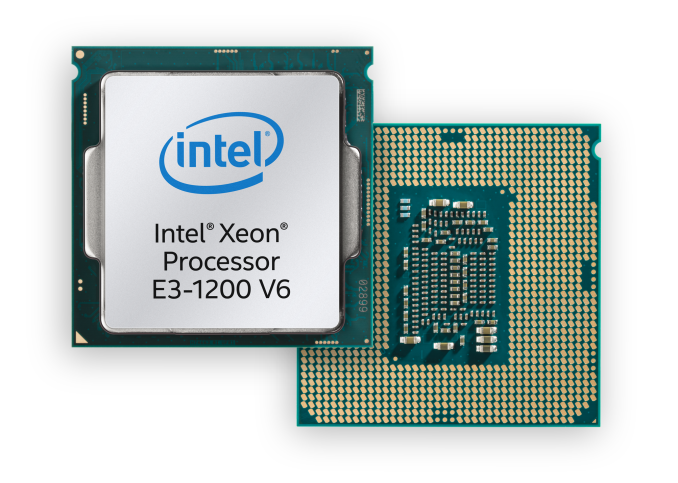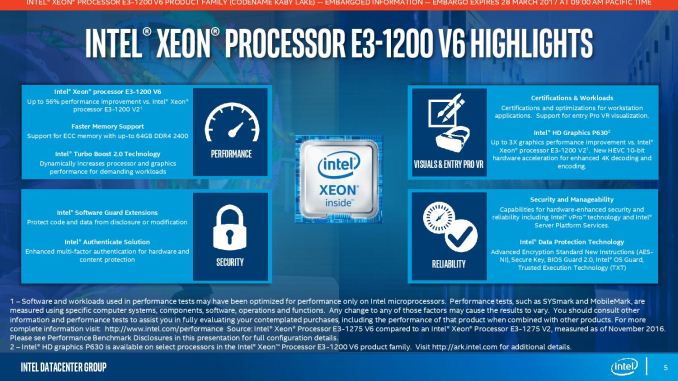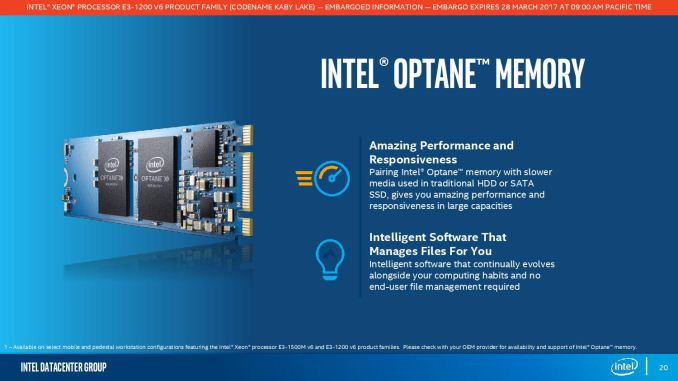Intel Launches Kaby-Lake based Xeons: The E3-1200 v6 Family
by Ian Cutress on March 28, 2017 12:00 PM EST- Posted in
- CPUs
- Intel
- Xeon
- Enterprise
- Enterprise CPUs
- E3
- Optane
- E3-1200 v6
- E3-1200

For the several generations previous, it has become customary for the Xeon equivalents of consumer processors to hit the market several months later. We saw the launch of Kaby Lake on the consumer desktop in January, with quad-core parts up to 4.0 GHz coming to retail. The Xeon E3 launch will be in the similar vein to previous years, designed for entry-level workstations, small business servers and storage servers, and Intel’s main comparisons for these Xeons will be to replace similar builds that are more than three years old.
A total of eight processors will be launched today under the E3 v6 name, with some models receiving a corresponding low-power version later down the line. All desktop replaceable CPUs will be using the LGA1151 socket, the same as the previous generation E3 v5 Xeons.
| Intel E3-1200 v6 CPUs (Kaby Lake) | ||||||||
| C/T | Base Freq | Turbo | L3 Cache | IGP | IGP Freq | TDP | $ | |
| E3-1280 v6 | 4/8 | 3.9 GHz | 4.2 GHz | 8 MB | - | - | 72 W | $612 |
| E3-1275 v6 | 4/8 | 3.8 GHz | 4.2 GHz | 8 MB | P630 | 1150 MHz | 73 W | $339 |
| E3-1270 v6 | 4/8 | 3.8 GHz | 4.2 GHz | 8 MB | - | - | 72 W | $328 |
| E3-1245 v6 | 4/8 | 3.7 GHz | 4.1 GHz | 8 MB | P630 | 1150 MHz | 73 W | $284 |
| E3-1240 v6 | 4/8 | 3.7 GHz | 4.1 GHz | 8 MB | - | - | 72 W | $272 |
| E3-1230 v6 | 4/8 | 3.5 GHz | 3.9 GHz | 8 MB | - | - | 72 W | $250 |
| E3-1225 v6 | 4/4 | 3.3 GHz | 3.7 GHz | 8 MB | P630 | 1150 MHz | 73 W | $213 |
| E3-1220 v6 | 4/4 | 3.0 GHz | 3.5 GHz | 8 MB | - | - | 72 W | $193 |
| E3-1205 v6* | 4/4 | 3.0 GHz | 3.0 GHz | 8 MB | P630 | 1000 MHz | 65 W | $193 |
*The E3-1205 v6 is 'off-roadmap', meaning it is not part of Intel's general release and usually produced at the request of a specific customer.
On the integrated graphics models, i.e. those ending in '5', are all running Intel HD P630 graphics and run up to 1150 MHz. This is the ‘professional’ version of the HD630 we see on the consumer parts, using Intel’s latest Gen9 graphics architecture and supporting H.265 encode/decode. Our Kaby Lake review piece goes into more detail.
The high-end E3 v6 parts will have a maximum base frequency of 3.9 GHz base and a 4.2 GHz turbo. All the parts listed have a full 8MB of L3 cache, and either be 72W for non-IGP models or 73W for IGP parts. As with other previous Xeons, these come with ECC memory support, vPro and other technologies Intel files under the professional level. In Intel’s presentations, Intel SGX (Software Guard Extensions) are included, however TSX (Transactional Extensions) were not listed.
| Intel E3-1200 v6 and v5 CPUs | ||||
| IGP | v6 | Model | v5 | IGP |
| - | 3.9/4.2, 72W | E3-1280 | 3.7/4.0, 80W | - |
| + | 3.8/4.2, 73W | E3-1275 | 3.6/4.0, 80W | + |
| - | 3.8/4.2, 72W | E3-1270 | 3.6/4.0, 80W | - |
| - | - | E3-1260L | 2.9/3.9, 45W | - |
| + | 3.7/4.1, 73W | E3-1245 | 3.5/3.9, 80W | + |
| - | 3.7/4.1, 72W | E3-1240 | 3.5/3.9, 80W | - |
| - | - | E3-1240L | 2.1/3.2, 25W | - |
| - | - | E3-1235L | 2.0/3.0, 25W | + |
| - | 3.5/3.9, 72W | E3-1230 | 3.4/3.8, 80W | - |
| + | 3.3/3.7, 73W | E3-1225 | 3.3/3.7, 80W | + |
| - | 3.0/3.5, 72W | E3-1220 | 3.0/3.3, 80W | - |
| + | 3.0/3.0, 65W | E3-1205* | - | - |
It is worth noting that for LGA1151 based E3 v5 Xeons, Intel adjusted the requirements such that Xeon processors require a server grade chipset on the motherboard. For Skylake E3 v5 parts, this was either a C232 or C236 chipset – we reviewed a few motherboards with these on (ASRock E3V5 Gaming, GIGABYTE Z170X-Extreme ECC). With a BIOS update, these C232/C236 motherboards should support the new v6 processors.
For the E3 v6 line, Intel is not releasing new chipsets, deciding to stick with the C232 and C236 models. This means that users wishing to upgrade their E3 v5 system will have to wait for a BIOS update in order for the new CPUs to work. We have yet to receive word if the standard motherboard manufacturers are launching a new series of motherboards for this generation, however we suspect that several will do so.
With the no new motherboard chipsets being launched, it is, therefore, odd that Intel is announcing Optane Memory support with the E3-1200 v6 Xeons. This essentially means that Optane Memory support is already baked into the chipset, and it is merely a firmware approval of a CPU and chipset combination in order for it to be enabled. Intel states that only select E3-1500M v6 (mobile) and E3-1200 v6 (desktop) configurations will be available for use with Optane, and may only be provided on an OEM basis.
| Intel Xeon E-Series Families (February 2017) | |||||
| E3-1200 v5 | E3-1500 v5 E3-1500M v6 |
E5-1600 v4 E5-2600 v4 E5-4600 v4 |
E7-4800 v4 | E7-8800 v4 | |
| Core Family | Skylake | Skylake | Broadwell | Broadwell | Broadwell |
| Core Count | 2 to 4 | 2 to 4 | 4 to 22 | 8 to 16 | 4 to 24 |
| Integrated Graphics | Few, HD 520 | Yes, Iris Pro | No | No | No |
| DRAM Channels | 2 | 2 | 4 | 4 | 4 |
| Max DRAM Support (per CPU) | 64 GB | 64 GB | 1536 GB | 3072 GB | 3072GB |
| DMI/QPI | DMI 3.0 | DMI 3.0 | 2600: 1xQPI 4600: 1xQPI |
3 QPI | 3 QPI |
| Multi-Socket Support | No | No | 2600: 1S/2S 4600: 1S/2S |
1S, 2S or 4S | Up to 8S |
| PCIe Lanes | 16 | 16 | 40 | 32 | 32 |
| Cost | $213 to $612 |
$396 to $1207 |
$294 to $7007 |
$1223 to $3003 |
$4061 to $8898 |
| Suited For | Entry Workstations | QuickSync, Memory Compute |
High-End Workstation | Many-Core Server | World Domination |
Along with Intel’s announcement, we are seeing systems being launched with E3 v6 processors installed. Prices of the new parts are equivalent to the last generation.
To call out a big elephant in the room: Intel has more competition in this space than in previous years. Intel gives value to Xeon processors above consumer products, but Ryzen could potentially be an alternative to Intel. Aside from AMD, some of the positioning that Intel puts forward with the E3 could be taken up by Intel’s Atom offerings, Xeon-D, or even musings from ARM partners on new silicon designs. All being said, Intel is still expected to have the peak single thread performance for general purpose compute, and has the larger install base of customers and ready-to-go platforms. Performance per watt will be a key metric to monitor as well.
We have the E3 v5 processors in for testing on our new CPU test suite, and we hope that the E3 v6 units will arrive in due course. Stay tuned for those.



















54 Comments
View All Comments
lefty2 - Tuesday, March 28, 2017 - link
So, these are just desktop Skylake CPUs with Xeon branding. I wonder if it'd be possible to do the same thing with Ryzen 7 CPUs?Kvaern1 - Tuesday, March 28, 2017 - link
They get to be Xeons when they have ECC support and a few other non core features and go through addional QA.Or in other words, no.
r3loaded - Tuesday, March 28, 2017 - link
You mean the ECC support that's present on the die but deliberately gimped by Intel on their desktop branded parts. Yeah, still (largely) a rebranding exercise to charge more for the same silicon.Yojimbo - Tuesday, March 28, 2017 - link
That ECC support wouldn't be there at all without these Xeon processors existing. It's not like the ECC support comes for free. It is bought and paid for and the cost is applied to the market that demands it. If not, the Core processors would lose competiveness because of higher cost and Intel would lose money by trying to serve the market for these Xeon processors. If that was the only other option they simply would choose not to bring these processors and the ECC that comes with them to market.prisonerX - Tuesday, March 28, 2017 - link
Wow, checking a parity bit, so expensive! Probably a quarter of the die, hey?Yojimbo - Tuesday, March 28, 2017 - link
I'm sure there's more to the difference between the Xeon and the Core chips than ECC support. That was just the particular example the previous poster mentioned. Do you think customers who buy Xeons are stupid or have no pricing power? Neither are true. The cynics in this forum just don't understand the metrics that are important to these companies.prisonerX - Wednesday, March 29, 2017 - link
Well I was struck by your "It's not like the ECC support comes for free" line, becuase it is essentially free. I don't think Xeon customers are stupid, but they certainly have no pricing power, Intel charges whatever it can keep a straight face with.Arguably most Xeons are rebranded desktop chips, albeit somewhat better binned ones with more L3 cache (which doesn't make that much difference) since they have the same cores and essentially the same feature sets. There is more to Xeons than EEC, but they're mostly gimmicks at worse and marginal, specialist features at best. In terms of mainstream use, which is 99% of the market, they make little difference.
Those "metrics" you talk about are just corporate buzzwords that corporate bozos use to justify their paychecks but actually make next to zero difference to what most companies do.
ACE76 - Wednesday, March 29, 2017 - link
Ceon only adds ECC...And higher core count variants at lower frequencies down the line...They don't perform any better than the desktop variant they are based on...I think in today's server market, ECC has become rather a non talking point anyway..Kind of like RAID 5 largely being considered useless...I've worked at various companies that used Dell workstations that didn't have ECC and held up for 24x7 usage as small servers just fine...Intel has had this market cornered for a long time, so they charge what they want... Hopefully AMD's Naples brings that to a screeching halt.fazalmajid - Tuesday, March 28, 2017 - link
And yet AMD manages to include ECC support for free in Ryzen, not just Naples.It's price-gouging market segmentation by Intel, nothing less.
Yojimbo - Tuesday, March 28, 2017 - link
AMD also has almost no data center business to speak of. Yeah, these companies are stupid and are just throwing their money away. Even worse than your implication of that is your abuse of the term "price-gouging".